You’ve heard of spring bulbs like tulips and daffodils, but have you heard about the bright colours of summer bulbs? Today, I’m offering you a little nudge to order some summer flowering bulbs, save some cash, and grow a large stash of these showstopping flowers!

Spring gardens are synonymous with tulips, daffodils, crocuses, and other spring-blooming bulbs. These cheery blooms are the first sign of the changing of seasons and you would be hard-pressed to find anyone who doesn’t delight in them. Those welcome flowers of spring mean it is also the time to start thinking about planting summer flowering bulbs.
Summer flowering plants offer colour at a time of year where the perennials, trees, and shrubs are just starting to wake up in the garden and there are plenty of reminders to gardeners to get these on your fall gardening list.

Summer blooming bulbs offer extraordinarily beautiful flowers that really stand out in the garden. They rise above the other flowers like works of art, showing some of the most decorative features that nature has to offer. Often, gardeners will purchase them as blooming plants at the garden center or as cut flowers from the farmer’s market in the summer.
Sponsored Content: I’m happy to partner with FlowerBulbs.com to share this list of summer bulbs for your garden. Some of the most resplendent flowers and leaves are grown from bulbs, tubers, corms, and rhizomes. Buy them now from catalogs and plant them early to save big bucks this year on showstopping plants.


Planting Summer Flowering Bulbs
When Should Summer Bulbs Be Planted?
Summer flowering bulbs have similar planting instructions as spring blooming bulbs, although they are planted in the spring, not the fall.
Summer flowering plants have some of the most decorative blooms and leaves available for your garden. But many are too tender to survive a cold winter, which is why you can’t plant them in the fall the way you can many other bulbs.
The planting instructions will vary a bit for each flower, so follow the guidelines provided with the bulbs. In general, most bulbs should be planted after the fear of frost has passed.
Should You Soak Summer Bulbs Before Planting?
Some bulbs, such as anemones, may need to be soaked for a couple of hours in warm water before planting. Typically, smaller and dry bulbs will benefit from soaking. However, most bulbs are dormant when planting, and soaking is not necessary.

Do Summer Bulbs Come Back Each Year?
Since most summer flowering plants like the heat, most of them only exist as perennials in semi-tropical climates. Look at the winter hardiness zones to see if a bulb will overwinter in your area.
If you live in a cool climate, most of these bulbs can still be planted as annuals. For most bulbs, you can also dig them up in fall after they have gone dormant and store them inside over the winter.
Come spring, plant the bulbs in pots 4 to 6 weeks before the last frost date in your area. Cover the bulbs with soilless potting mix and place in a sunny window. Water sparingly until you see the plant growing. Move them out to the garden as soon as you’ve safely passed the frost date.

16 Summer Flowering Bulbs to Plant for Showstopping Blooms
Here is a list of my absolute favourite summer bulbs to plant in the spring. It’s worth investing in some of these bulbs from catalogs in the spring because buying them in pots in the summer can be very expensive. With a little know-how in the spring, you can enjoy a gorgeous flower garden bursting with blooms this summer without breaking the bank.
Lilium
Lilium (lilies) are beautiful, hardy, and super easy to grow. They come in a wide variety of colours, so you can find one to suit any design style. Plant lilies where they can reach above more dense, decorative foliage plants so that they create a burst of firework blooms above the garden.
Note that lily pollen is very toxic to cats. Just a bit of pollen on a cat’s fur can be ingested as they groom themselves, and this can cause a serious adverse reaction. Please consider planting an alternative if you garden with a feline friend.
- USDA hardy zones: 4-9
- Type of bulb: true bulb
- Flower colour: most colours
- Flowering period: June-August
- Average plant height: 28-40 inches
- Planting depth to the base of bulb: 6 inches
- Spacing between bulbs: 12 inches
- Light requirements: partial shade

Crocosmia
Crocosmia looks elegant and exotic with delicate flower chains in shades of orange, red, and yellow. These pretty plants are easy to divide, so you can spread their beauty all over your garden!
My first clump came from my mother’s garden, and I would simply divide it when it got too large. Throughout the summer and fall, it grew beautiful flowers that were covered in pollinators and hummingbirds, and the seed heads made for stunning dried flower arrangements.
- USDA hardy zones: 6-9
- Type of bulb: corm
- Flower colour: orange, red, yellow
- Flowering period: August-September
- Average plant height: 24-30 inches
- Planting depth to the base of bulb: 2 inches
- Spacing between bulbs: 4 inches
- Light requirements: full, morning sun

Dahlia
Dahlias are not only showy and make great cut flower arrangements, but they are also some of the longest bloomers in the garden. They will start blooming in the summer months and, as you cut the flowers off, they will send up more blooms until frost finally takes the plant to the ground. In my area, this can be late November! Dahlias are wonderful for their impressive variety. They come in every colour of the rainbow as well as sizes ranging from small, two-inch flowers to blooms the size of a dinner plate!
- USDA hardy zones: 8-11
- Type of bulb: tuber
- Flower colour: all colours
- Flowering period: July-October
- Average plant height: 8-20 inches
- Planting depth to the base of bulb: 2-3 inches
- Spacing between bulbs: check your dahlia for specifics
- Light requirements: sun
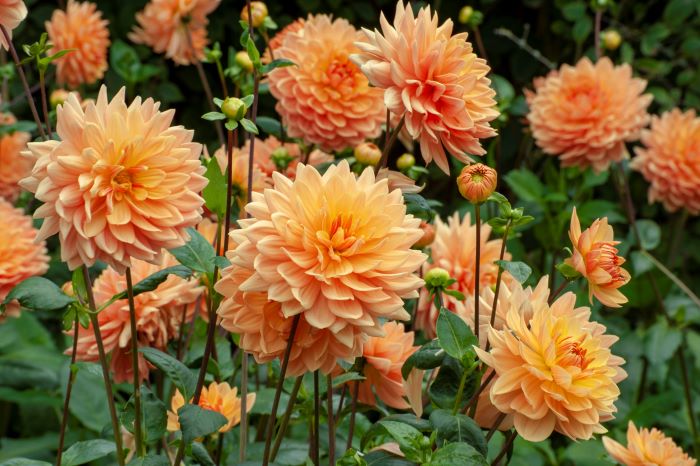
Gladiolus
These tall, trumpet-shaped flowers are especially impressive growing behind other blooming plants. Their height and large flowers won’t be outshone by shorter plants growing in front and the various sizes will add interest.
Plant gladiolus corms in a sunny location in well-draining soil. Plant corms every few weeks to extend the flower blooms in the garden. Start planting the first corms in spring, 2 weeks before the last frost date, and keep planting every 2 weeks until the second week of summer.
- USDA hardy zones: 8-11
- Type of bulb: corm
- Flower colour: all colours
- Flowering period: July-September
- Average plant height: 20-40 inches
- Planting depth to the base of bulb: 4 inches
- Spacing between bulbs: 5 inches
- Light requirements: full sun

Gladiolus Callianthus
Delightfully fragrant, gladiolus callianthus are an orchid-like flower with sword-like foliage. These bulbs are very affordable, and you can easily treat them as annuals. Their size also makes them ideal for containers and they work well on a sunny patio or deck.
- USDA hardy zones: 7-10
- Type of bulb: corm
- Flower colour: white
- Flowering period: July-October
- Average plant height: 24-36 inches
- Planting depth to the base of bulb: 4 inches
- Spacing between bulbs: 6 inches
- Light requirements: full sun, afternoon sun
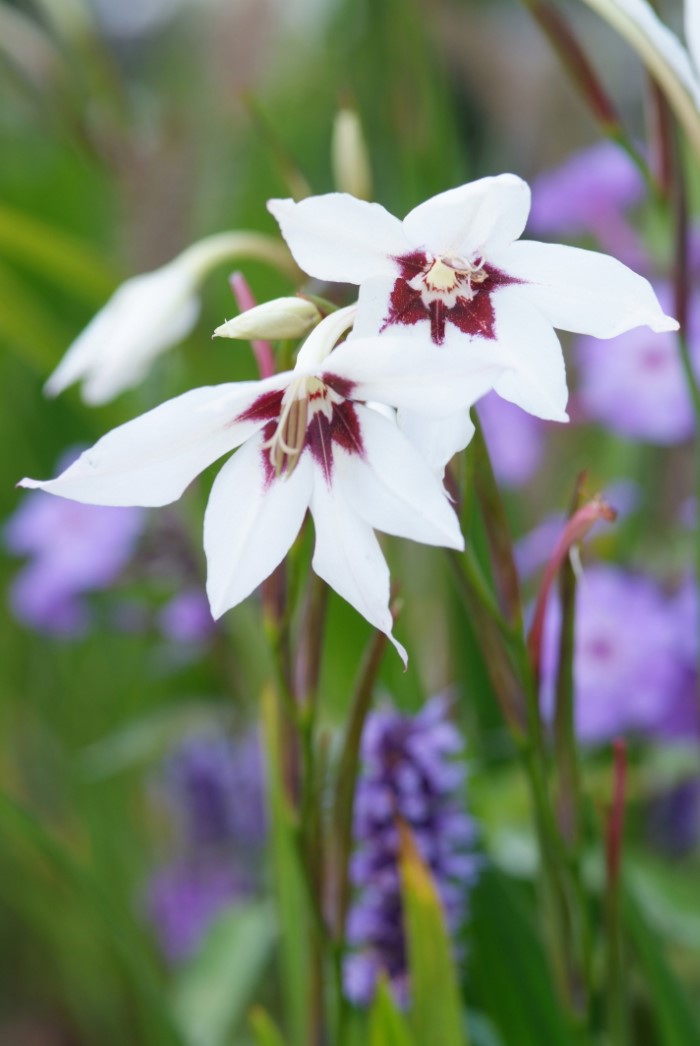
Calla Lily
Although it isn’t a true lily, the calla lily is still a gorgeous flower to include in your summer garden or even indoors as a houseplant. They work as long-lasting cut flowers, their long tubular shape offering a striking variety to a bouquet.
- USDA hardy zones: 8-10
- Type of bulb: rhizome
- Flower colour: white, pink, rust, yellow, and more
- Flowering period: July-October
- Average plant height: 12-36 inches
- Planting depth to the base of bulb: 4 inches
- Spacing between bulbs: 16 inches
- Light requirements: full sun but tolerates partial shade

Freesia
A popular cut flower, freesias are also a welcome addition to the garden due to their abundance of flowers. They grow in a cluster and require minimal maintenance, being virtually pest and disease-free. As an added bonus, they are deer and rabbit resistant.
- USDA hardy zones: 9-10
- Type of bulb: corms
- Flower colour: all
- Flowering period: June-September
- Average plant height: 6-12 inches
- Planting depth to the base of bulb: 2 inches
- Spacing between bulbs: 3 inches
- Light requirements: sun
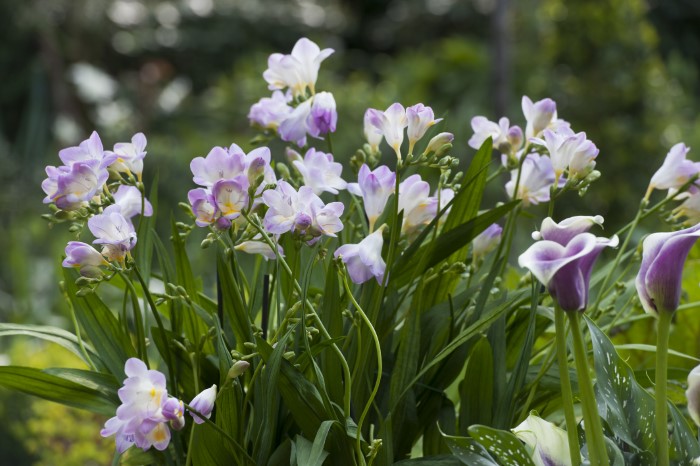
Hymenocallis
If you’re looking for a unique-looking flower, hymenocallis is your bulb. These exotic flowers are often called spider lily due to their curled petals, resembling spider legs. The flowers are very fragrant and the leaves are long and strappy, similar looking to amaryllis.
- USDA hardy zones: 8-10
- Type of bulb: true bulb
- Flower colour: white, yellow
- Flowering period: mid June-July
- Average plant height: 12-24 inches
- Planting depth to the base of bulb: bulb just under the ground level, neck above surface
- Spacing between bulbs: 8 inches or 1 bulb in a 5-inch pot
- Light requirements: sheltered and sun, afternoon sun
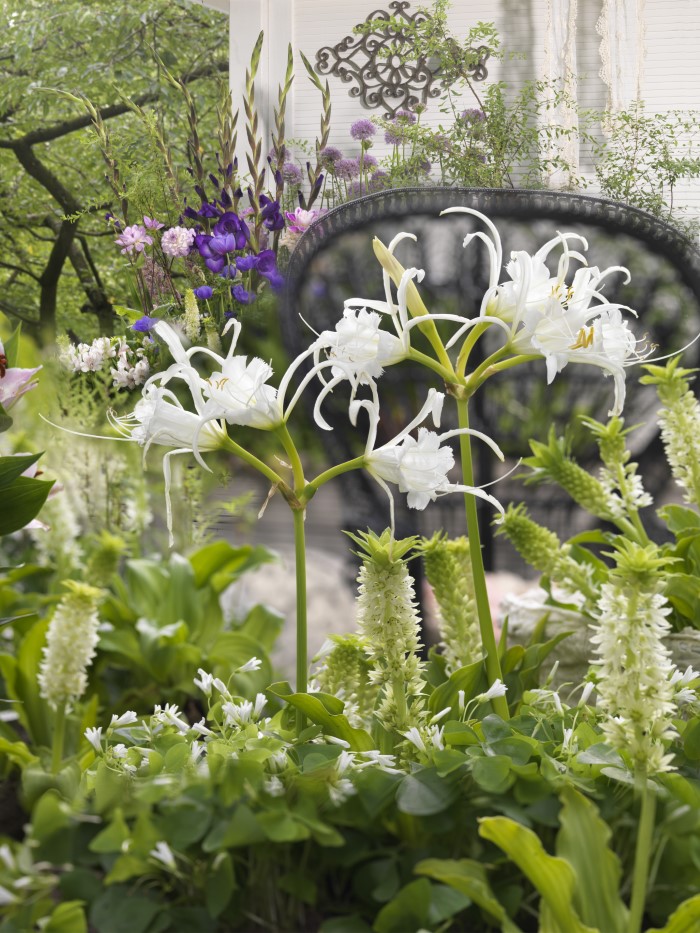
Indian Shot Plant (Canna)
Colourful and flamboyant, cannas are striking from their leaves to their tall blooms. The leaves are paddle-shaped and large. A tropical plant, cannas handle the heat of summer well having bloom all the way into the fall.
- USDA hardy zones: 7-11
- Type of bulb: rhizome
- Flower colour: white, orange, yellow, pink, red
- Flowering period: July-October
- Average plant height: 32-80 inches
- Planting depth to the base of bulb: deep enough to cover with soil
- Spacing between bulbs: 12 inches
- Light requirements: full morning sun

Ixia
Some bulbs like it hot and dry! Ixia is ideal for southwest climates and other warm areas. Like most summer bulbs, the colour is extravagant and it often has contrasting spots to be admired. Plant ixia together in containers or along borders to make a strong visual impact.
- USDA hardy zones: 8-10
- Type of bulb: corm
- Flower colour: most colours
- Flowering period: June-August
- Average plant height: 12-18 inches
- Planting depth to the base of bulb: 8 inches
- Spacing between bulbs: 3 inches
- Light requirements: full sun

Liatris
Tall, spikey, and magnificent, liatris are a fuzzy (usually) purple blossom. The stalks emerge from grass-like leaves that last long after the flower stalks have come and gone. Butterflies love liatris and you can grow these bulbs in cooler climates as they are fairly tolerant of cold.
- USDA hardy zones: 3-8
- Type of bulb: corm-like roots
- Flower colour: purple, white
- Flowering period: July-August
- Average plant height: 30 inches
- Planting depth to the base of bulb: 1 inch
- Spacing between bulbs: 6-8 inches
- Light requirements: sun, morning sun

Oxalis
Not to be mistaken for clover, oxalis are a shamrock-like plant that is native to tropical climates. Most often grown as a houseplant, they also work well as summer flowering bulbs. The flowers open when the sun is out and close up when it becomes dark.
- USDA hardy zones: 8-11
- Type of bulb: bulb, tuber, rhizome, rootstock (depending on the variety)
- Flower colour: pink, white
- Flowering period: all summer
- Average plant height: 4-12 inches
- Planting depth to the base of bulb: 2 inches
- Spacing between bulbs: 2 inches
- Light requirements: warm and sunny

Ranunculus
Ranunculus are hard to spot in home gardens and I don’t know why! They are picture-perfect flowers with mounds of thin petals. They come in a range of colours and work well in containers or as cut flowers. Many flower shops adore including ranunculus in their bouquets.
- USDA hardy zones: 8-10
- Type of bulb: corm with ‘claw’ roots
- Flower colour: white, yellow, pink, gold, orange, red
- Flowering period: June-August
- Average plant height: 12-24 inches
- Planting depth to the base of bulb: 1-2 inches
- Spacing between bulbs: 3 inches
- Light requirements: sun, afternoon sun

Sauromatum
This flower is so delightfully strange. You won’t find its spotted, dark colouring, and unique shape on any other plant. It emits an unpleasant odour to attract flies, its main source of pollination, for a short period of time so it suggested to keep away from windows and doors.
- USDA hardy zones: 8-10
- Type of bulb: tuber
- Flower colour: yellow-orange with purple-red mar
- Flowering period: late spring-early summer
- Average plant height: 18 inches
- Planting depth to the base of bulb: 3-4 inches
- Spacing between bulbs: 6-8 inches
- Light requirements: indirect sun

Tuberous Begonia
The begonia is a favourite summer flower and for good reason! They come in a variety of shades and shapes and bloom throughout the whole summer. They thrive in shade making them a great plant to brighten up darker places in your garden.
- USDA hardy zones: 9-10
- Type of bulb: tuber
- Flower colour: red, pink, orange, yellow, white, purple
- Flowering period: June-October
- Average plant height: 10-16 inches
- Planting depth to the base of bulb: just covered with soil
- Spacing between bulbs: 6 inches
- Light requirements: partial shade, direct sun causes burning
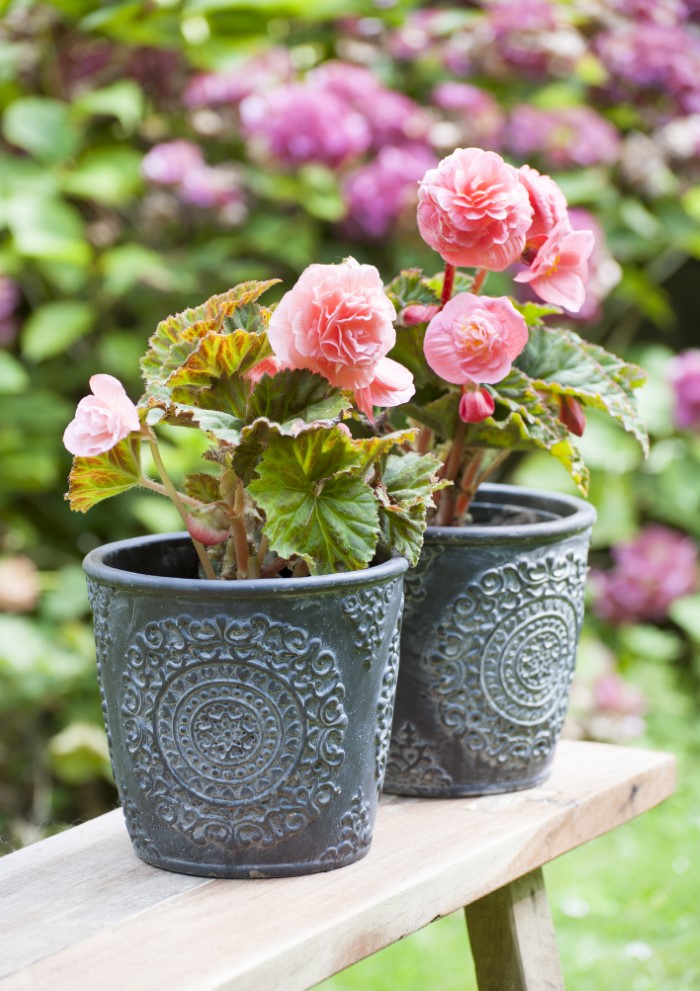
Windflower (Anemone)
These poppy-like flowers have some of the most striking, jewel-tone shades out there. Windflowers are delicate perennial flowers that will slowly form small colonies. Divide them in the fall every few years to keep them in check or simply let them spread!
- USDA hardy zones: 4-8
- Type of bulb: tuber
- Flower colour: blue, red, white, pink
- Flowering period: May-August
- Average plant height: 12-16 inches
- Planting depth to the base of bulb: 2 inches
- Spacing between bulbs: 4 inches
- Light requirements: sun or partial shade






Hi Stephanie, Are the plants you mentioned good for a place like Toronto, Ontario? Please let me know. Thanks, Gowri
Hi Gowri, the best way to know if look for the hardiness zones on the bulb’s labels. Toronto is somewhere around a Zone 6, so anything that is hardy at Zones 6 or lower should be fine. That being said, you can grow the others and dig up the bulbs for winter storage. The hardiness zones mean that the bulbs are only hardy in the ground in those zones.
With a little know-how in the spring, you can enjoy a gorgeous flower garden bursting with blooms this summer.
The constant stream of pop-up ads is outrageous. I only read a quarter of this article because of how frustrating all your pop-up ads.
Hi, Off the Summer bulb topic and onto the Forced Spring bulbs which I bought in February. Can I put them in the ground late March after they dry, will they survive? They probably wouldn’t bloom again mid May? Also, I am taking some of them gradually out of the pots and laying on top off the soil, stored in my cold room today. Is that OK? Thanks, Elizabeth in PEI, Canada.
They wont bloom again this year but maybe will survive until next spring and naturalize.